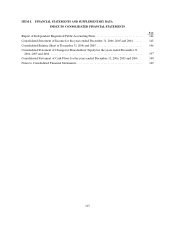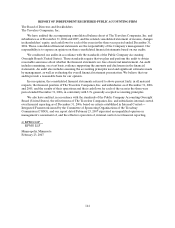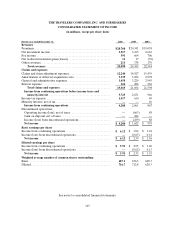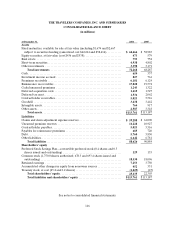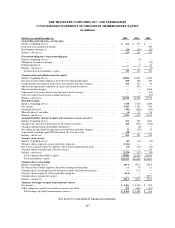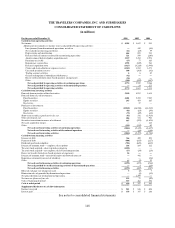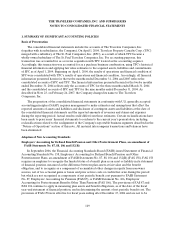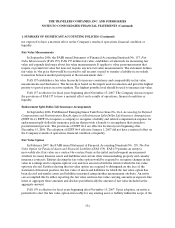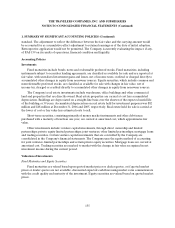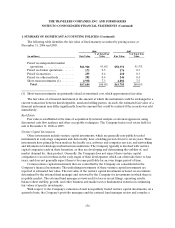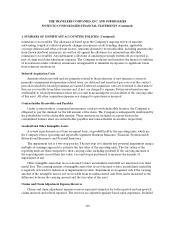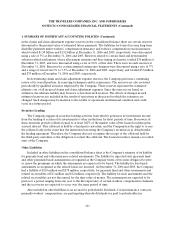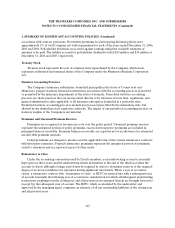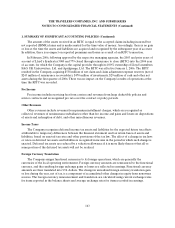Travelers 2006 Annual Report Download - page 165
Download and view the complete annual report
Please find page 165 of the 2006 Travelers annual report below. You can navigate through the pages in the report by either clicking on the pages listed below, or by using the keyword search tool below to find specific information within the annual report.THE TRAVELERS COMPANIES, INC. AND SUBSIDIARIES
NOTES TO CONSOLIDATED FINANCIAL STATEMENTS (Continued)
153
1. SUMMARY OF SIGNIFICANT ACCOUNTING POLICIES (Continued)
only an embedded derivative that is tied to the prepayment risk of the underlying prepayable financial
assets and if both of the following criterion are met: (a) the investor does not control the right to
accelerate the settlement, and (b) the securitized interest does not contain anembedded derivative for
which bifurcation would be required other than an embedded derivative that results from embedded call
options in the underlying financial assets. B40 is effective upon the adoption of FAS 155, except for
criterion (b) which is not applicable to securitized interests issued before June 30, 2007, and that only
include embedded derivatives that have an extremely remote possibility of having greater than a trivial fair
value during the life of the securitized interest.
FAS 155 is effective for all financial instruments acquired, issued orsubject to a remeasurement (new
basis) event occurring after the beginning of an entity’s fiscal year that begins after September 15, 2006. At
adoption, for contracts where the fair value option has been elected, any difference between the total
carrying amount of the individual components of the existing bifurcated hybrid financial instrument and
the fair value of the combinedhybrid financial instrument should be recognized as a cumulative-effect
adjustment to beginning retained earnings. The Company adopted FAS 155 effective January 1, 2007.
Since it did not elect the fair value option, it did not have a cumulative effect upon adoption of FAS 155.
The ongoing effectof adopting FAS155 will not be material to the Company’s results of operations,
financial condition or liquidity.
Accounting for Uncertainty in Income Taxes
In July 2006, the FASB issued Interpretation No. 48, Accounting for Uncertainty in Income Taxes - an
Interpretation of FASBStatement No.109 (FIN 48). FIN 48 clarifies the accounting for uncertainty in
income taxes recognized in a company’s financial statements and prescribes the recognition and
measurement of a tax position taken or expected to be taken in a tax return. FIN 48 also provides guidance
on de-recognition, classification, interest and penalties, accounting in interim periods, disclosure and
transition.
Under FIN 48, evaluation of a tax position is a two-step process. The first step is to determine whether
it is more-likely-than-not that a tax position will be sustained upon examination, including the resolution of
any related appeals or litigation based on the technical merits of the position. The second step is to
measure a tax position that meets the more-likely-than-not threshold to determine the amount of benefit
to be recognized in the financial statements. A tax position is measured at the largest amount of benefit
that is greater than 50 percent likely of being realized upon ultimate settlement.
Tax positions that previously failed to meet the more-likely-than-not recognition threshold should be
recognized in the first subsequentperiod in which the threshold is met. Previously recognized tax positions
that no longer meet the more-likely-than-notcriteria should be de-recognized in the first subsequent
financial reporting period in which the threshold is no longer met.
In February 2007, the FASB announced that it plans to issue a FASB Staff Position (FSP) to amend
FIN 48. The proposed FSP is expected to be exposed for a 30-day commentperiod and, if adopted, would
be effective at the time a company initially adopts FIN 48.
FIN 48 is effective for fiscal years beginning after December 15, 2006. The estimated impact of
adopting FIN 48 at January 1, 2007, before consideringthe impact, if any, of the yet to be issued FSP, is


